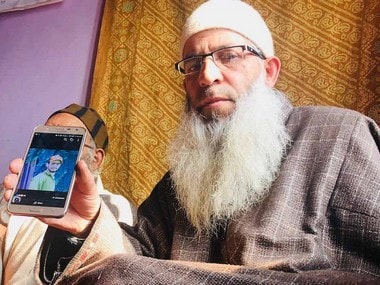Amid rising encounters in Kashmir, jihadists resort to Islamic State-like tactics to instil 'fear', command deference
A bright-pink blanket was wrapped over Huzaif Kutay’s head, binding it to the neck from which it had almost been severed by his killer’s knife. His executioners had recorded the last moment of the teenager’s life in their cellphones, in a style the world was introduced to by the Islamic State: masked men standing over the teenage boy, announcing judgement in God’s name for being an army informer.
He had begged for forgiveness. "They said they would give me Rs 10,000 (for every terrorist). I thought it will help me waive off some of my loan," Kutay told his interrogators.
"This time we are leaving his head so that it serves as a lesson," a killer announced in the video.
"Next time, whoever is caught, their head will be thrown in the river," he added.

Ashraf Kutay shows image of his son Huzaif, who was executed by militants. Image courtesy: Sameer Yasir
Few of the thousands of people who live in the village of Mazngam in south Kashmir’s Kulgam district, came to his funeral. Their absence helps understand why jihadists have turned to this pornography of violence, and why it is succeeding.
More than 200 terrorists have been killed in the Kashmir Valley this year — thirty-six between 20 October and 17 November, the day Kutay was murdered. The jihadists simply can’t sustain that level of attrition, nor launch enough operations to deter the offensive. Thus, terrorising the civilians into breaking ranks with security forces has become a key strategy, and social media has become a platform for their project.
"There is an increasing pressure on the militants," a senior police officer in Srinagar said. "Their area has been squeezed and their logistic networks challenged. Besides, recruitment has also been brought under control," the officer informs.
Lacking strong links to their organisations’ headquarters in Pakistan-occupied Kashmir, and compelled to raise both finances and weapons locally, fear has become a key weapon for the new generation of jihadists who began to emerge in 2014. Like narcotic gangs in other countries, many jihadists now operate in and around their native villages, and are dependent on terror to both deter informers, and ensure the deference of the established village élite.
In April this year, a father-son duo were again kidnapped. While the father managed to escape. The next month, 38 year old Mohammad Yaqoob Wagay’s throat was slit in front of his family, including his seven-year-old son.
Hajin is the stronghold of the Pakistan-based jihadist outfit, Lashkar-e-Taiba (LeT). However, the LeT, denied its involvement.
In August, a woman was shot dead at point-blank range in Pulwama district's Drubgam village — the native village as well as the site of the gunfight in April which claimed the life of Hizb-ul-Mujahideen commander Sameer Bhat, also known by the alias ‘Tiger’.
Locals claim that the woman was Bhat’s lover. A WhatsApp group run from a Pakistani number, identifying itself with the Hizbul Mujahideen, circulated a message shortly after her death, charged her with having betrayed the Hizb-ul-Mujahideen commander.
"This lady Shameema Akhtar had contacts with all the police officers and army officials. She had blood of our brothers on her hands,” the message read.
Killings like these have been a part of Kashmir’s grim landscape for over two decades: executions, often involving beheading and mutilation, have occurred with depressing regularity. The difference now is that they are being advertised. In the past, killings of civilians were attributed to mysterious “unidentified gunmen”, but now, jihadists do not shy away from taking responsibility.
In a widely-circulated recording of a phone conversation between Riyaz Naikoo, the Hizb-ul-Mujahideen ’s chief in Kashmir, and the outfit’s Shopian head, the latter agrees with Naikoo’s instruction to “throw acid in their (informers) eyes and cut their legs so they become handicapped and a burden on their families”.
Though the killings have attracted condemnation from figures like former Chief Minister Omar Abdullah, in jihadists’ funerals across Kashmir, slogans attacking collaborators have become enmeshed with slogans like "Mukhbiran byoul, khodayen goel (may god obliterate informers)".
Political leaders in south Kashmir say that the killings, in fact, enjoy a degree of social sanction. However, other activists claim that the killings are intended to put down stirrings of rebellion against militancy.
One of Kutay's sister said, "If they claim that 90 percent of Kashmir is with them, it would be counterproductive. For now, the militants' actions have reached their short term goal of spreading fear but resentment is becoming visible. They say they are doing jihad but they are only killing civilians. Why don’t they fight the army?”
"If this is jihad, we do not want it. If this is their idea of Islam, that is not acceptable to us,” she added.
Source: https://www.firstpost.com/india/amid-rising-encounters-in-kashmir-jihadists-resort-to-islamic-state-like-tactics-to-instil-fear-ensure-deference-from-locals-5609491.html
Comments